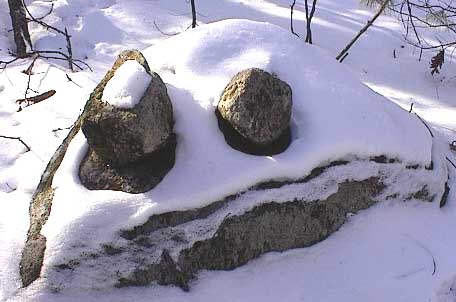
After you see it enough times you start to become aware of a pattern: two smaller rocks sitting on top of a larger rock, both smaller rocks with a peculiar shape like a "boat rudder" or "cashew".

Usually one of the two is more clearly shaped than the other. Some typical variations of this shape are illustrated:

Because they appear in pairs I call them Twins. Not only is it true that the "boat rudder" shape usually occurs in a pair, it is also true that pairs usually exhibit this shape. In other words they are paired if and only if they are shaped this way. This is a strong statement and leads to the burning question: what is it a pair of? Unfortunately it is too soon to know anything significant about this phenomenon, although some whimsical speculation is provided at the end of this article. The goal for now is descriptive, with the hope of showing examples and establishing this as a repeated pattern. I will discuss things which can be observed about these pairs such as: are they common and how are they placed with respect to other features. Twins are rarely isolated and almost always occur as part of a larger collection of stone construction including such features as split-wedged rocks, rock-on-rocks, and more substantial rock piles. Here, Twins are considered as one typical component in the organization of such sites.
Acton:
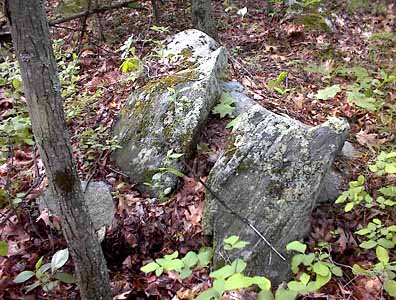
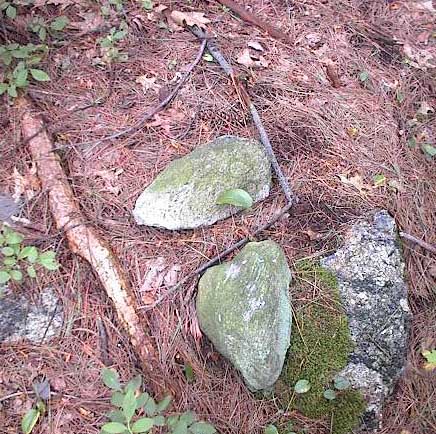
The first picture shows the first example of Twins that was observed. A friend noticed the peculiar repeated shape and commented on it.
Boxborough:
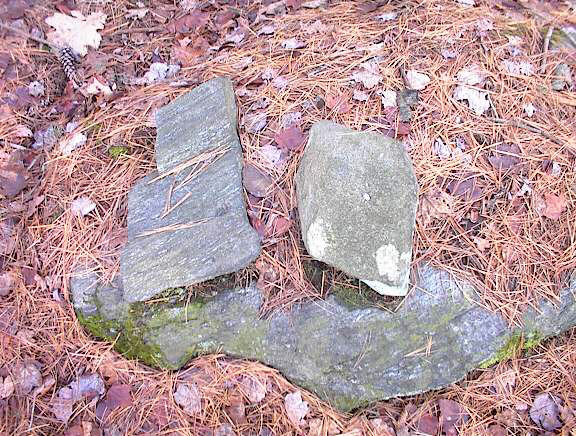
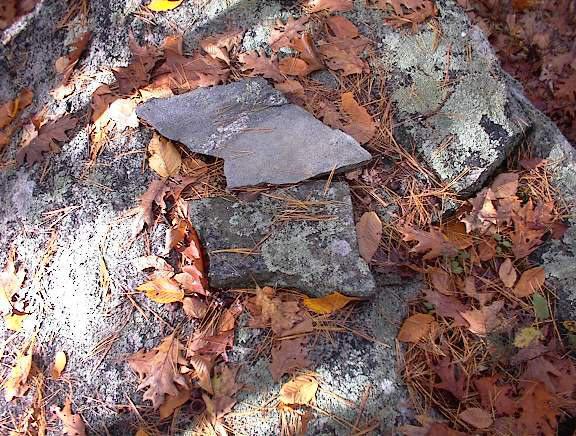
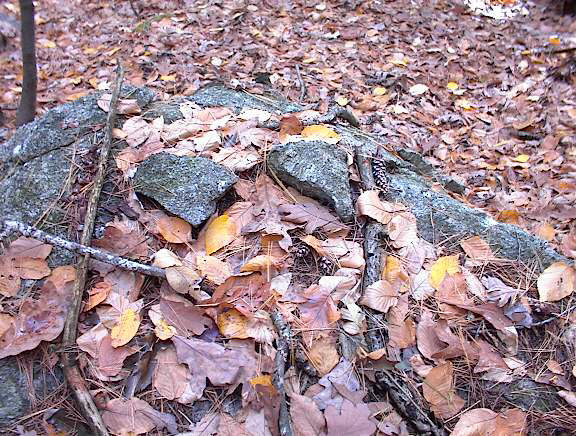
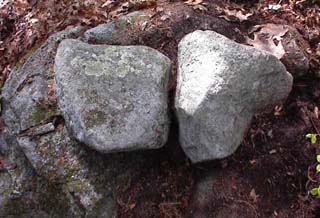
Lincoln:
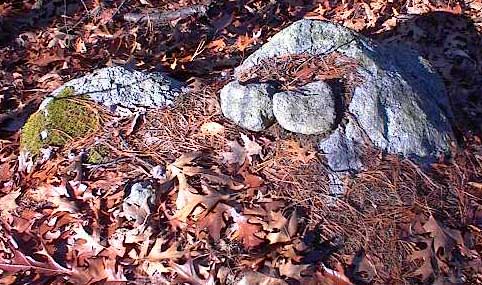
Note there are really three "cashew" shapes in this picture if we include the larger rock supporting the two smaller ones. There are other examples of parallelism between the larger and smaller rocks. For example this one below and also possibly the first picture from Boxborough above.
Littleton:

Northfield:
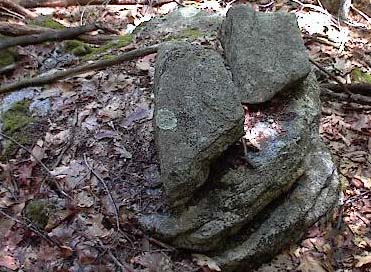
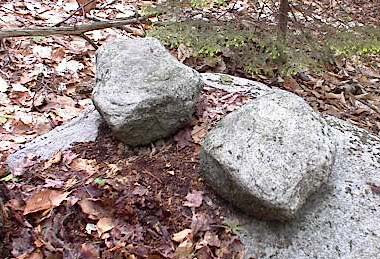
Note in these examples how the shapes are reversed and pointing in opposite directions.
Stow:
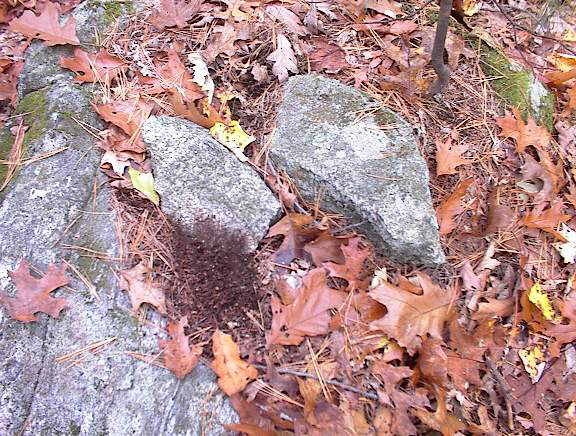
Note that shapes are reversed in the examples from Stow and Northfield but parallel in the ones from Acton and Lincoln.
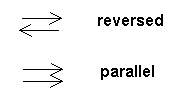
This could be of no significance or it could be worth observing. There are many possible interpretations of the shapes for which the notion of reversal would make sense.
There appear to be examples of pairs occuring in a different way. For example, this rock-on-rock from the Boxborough side of Flagg Hill shows a parallelism between upper and lower rocks both of which have the special Twin shape.

In the next example, two rock-on-rocks occur near each other.

Upon closer inspection, each one has this same peculiar shape, suggesting that they are intended as Twins.
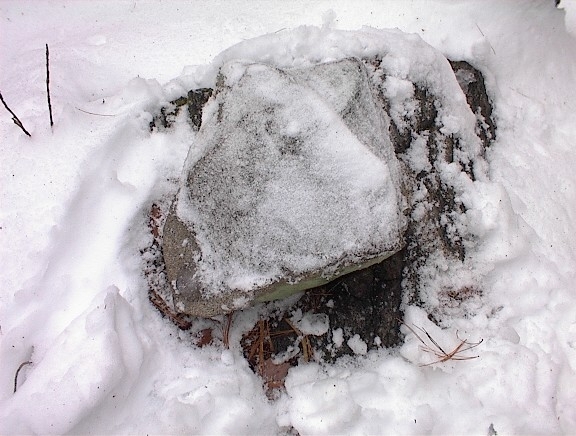
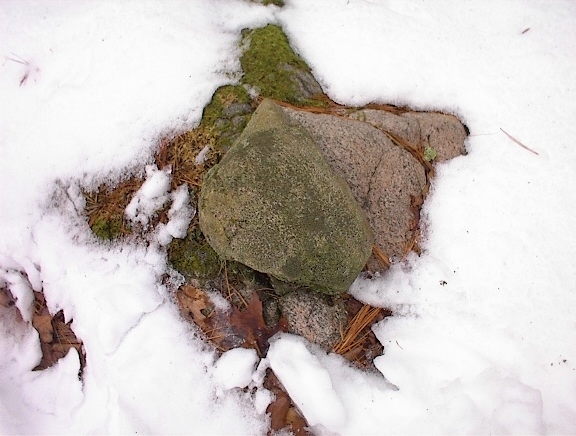
One can make some tentative observations about the placement of Twins within the larger organization of a rock pile site.
These are very tentative statements which need to be tested.
Many rock pile sites do not have examples of Twins, so Twins are a comparatively rare phenomenon. Reviewing the known examples, they are all from north and west of the Sudbury River. Like split-wedged rocks, they have not yet been found further south. It appears from limited observations, that they have a distribution which is broader than the range for split-wedged rocks but narrower than the range for rock-on-rocks. More precisely, Twins have been found everywhere that split-wedged rocks have been found except they also appear in Northfield, further west in Massachusetts, where split-wedged rocks were not found. So far, rock-on-rocks have been found everywhere.
An initial reaction upon noticing twins shaped like this is that the shape might be
a variation on the "Manitou Stone" described by Mavor & Dix (1). They describe a
"head and shoulders" and give several illustrations of rocks shaped
something like this:
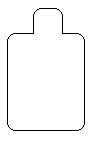
Some photos of Manitou Stones are available online on the NEARA Gallery website, for example this one from Derek Gunn is a good example for comparison. I believe this is not a correct identification for the Twins shape. The reason is that a symmetric shape with the "head" in the middle (not at the corner) has so far never occurred among Twins examples. Whenever there is a head-like protrusion, it is always off center and the typical variations never encompass the "Manitou Stone" shape.
Another possibility came up while watching a TV commercial where only the upper portion of the Cheerios package was displayed, showing the top portion of the heart shaped bowl containing the cereal [above the solid line in the illustration].
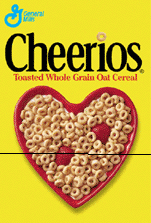
Seeing that, while writing this article, the similarity with the upper portion of the "heart" and the "cashew" catches the eye. Since the abstract "heart" shape of European culture is not anatomically correct, it is possible some other culture would come up with a different abstraction. For example, this might be closer to being anatomically correct. In any case, the "boat rudder"/"cashew" shape of Twins could be the representation of a heart.
In western culture, the pairing of hearts has a traditional meaning, involving romantic love:
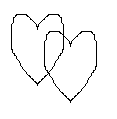
It is not likely that Native Americans shared this tradition, so speculation in that direction has little justification. Yet an idea about this shape must come from somewhere if we hope to make progress in understanding the meaning of the Twins pattern. Whether it is a heart, a head-and-shoulders, or some other entity, it seems clear that a deliberate representation is intended. This shape had a persistent meaning shared by one culture throughout an area that included the land north of the Sudbury River. Also, whatever representation is intended, it must make sense for it to occur in pairs. It could be mythological Twins, it could be a pair of lovers, it could be a contract. Whatever it is, it must be something for which the pairing is natural and meaningful.
An interesting supporting observation of the idea that the mystery shape is a heart arises while describing "burial outlines" in a later article. The rock pile shown below is assumed to be a burial with a headstone at the top of an outline. If you look inside the outline there is a shaped rock in about the right location to be a heart and it has the cashew shape.
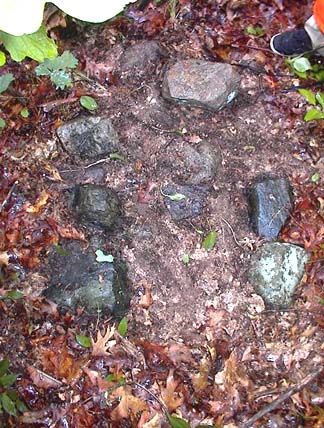
If this is the correct identification of the special shape occuring in Twins, the next question is: what does the pair mean? Perhaps it represents a promise.
(1) Manitou - The Sacred Landscape of New England's Native Civilization. James W. Mavor, Jr. and Byron E. Dix. Inner Traditions International, Ltd. One Park Street Rochester, VT 05767 (1989) pp. 332-340